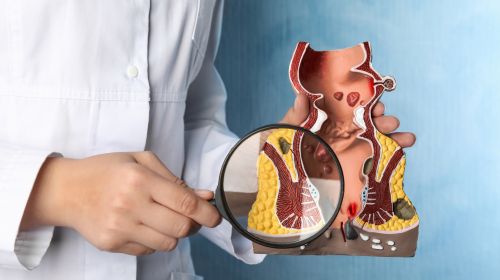A fungus on the anus is often noticeable through itching and redness in the anal area. Even if the symptoms are unpleasant, the infection can usually be treated easily. Here you can find out how you can recognize a fungus on the anus, which ointments help and how long it takes to heal!
- © Getty Images/athima tongloom
Quick overview: Frequently asked questions and answers
How do I recognize a fungus on the anus? Red, scaly spots are typical of a fungal infection in the anal area. The infection is usually very itchy and can burn.
What helps against a fungus on the anus? A special ointment is used that contains an antifungal agent. Tablets rarely have to be taken.
How long does a fungal infection in the anus last? The duration of treatment depends on how well those affected respond to the measures and which fungus is responsible. In the case of candidiasis, a minimum treatment period of 14 days is required.
At a glance:
What is anus fungus?
A fungus on the anus is an infectious disease of the skin; medical experts refer to this as dermatomycoses. The most common cause is the yeast fungus of the genus Candida (Candida albicans).
But not only yeast fungi can cause mycosis in the anus; filamentous fungi (dermatophytes) can also be a possible trigger. This is not called candidiasis but rather tinea corporis.
Interesting to know: In most cases, fungal infections are caused by the body’s own fungi. It is completely normal for a certain amount of yeast to colonize the skin and mucous membranes. Excessive reproduction can lead to infection.
Fungus on the anus has typical symptoms
A fungus on the anus usually causes the following symptoms:
- itch
- Burn
- Redness of the skin
- Formation of reddish plaques (spotty, slightly raised skin lesions)
- flaky skin
- Blisters or pustules
Other anal diseases: eczema or fungus?
It should be noted that other anal diseases, such as anal eczema, can be associated with similar symptoms. This is a rash that also itches and burns. The skin in the anus area is red and often oozes.
Itching and burning in the anus also often occur in connection with hemorrhoidal disease. Hemorrhoids are vascular cushions at the exit of the rectum, which can become pathologically swollen due to various triggers and cause symptoms such as itching, burning, oozing or bleeding.
Therapy: How is a fungus on the anus treated?
In general, a fungal infection in the anal area is harmless and can be easily treated. An antifungal agent (antimycotic) is usually used in the form of ointments or creams with the active ingredients nystatin or clotrimazole. They are applied to the affected areas.
To support the healing process, those affected should definitely avoid scratching. There is a risk that the sensitive anal region will be injured, inflammation will occur and the pathogens can spread further.
Sitz baths, for example with chamomile, can soothe the irritated skin around the anus and thus alleviate the symptoms. However, they do not address the cause. Medical advice should be sought before use.
What causes a fungus on the anus?
Various triggers can lead to an overgrowth of fungi in certain parts of the body and a pathological infection. Possible causes include:
weak immune system: If the immune system is weak, skin or intestinal fungi that naturally live on or in the body can multiply uncontrollably and trigger an infection.
certain underlying diseases: In particular, people with diabetes mellitus or circulatory disorders have an increased risk of developing a fungal infection.
Overweight: Morbid overweight (obesity) is a possible trigger, as increased sweat forms in the skin folds of the body. This creates a warm, humid environment that provides the ideal breeding ground for fungi.
Diapers: The so-called diaper thrush (diaper dermatitis) is a common infectious disease among newborns: The warm, damp diaper, which is usually wetted with urine and stool, is an ideal breeding ground for fungi. Not just babies, but also adults who wear diapers (incontinence pants). , may be affected.
certain medications: Antibiotics in particular can promote a fungal infection. In addition to the pathogenic bacteria, they also damage beneficial bacteria that control the growth of yeast fungi such as Candida.
moist skin areas: In general, candidiasis occurs primarily on excessively moist areas of skin. Typical areas include the groin region, the armpits, areas between fingers and toes or skin folds under the breasts.
Fungus on the anus: This is how the diagnosis works
Anyone who suspects they have a fungal infection in the anus can contact a family doctor. The doctor will first inquire about the symptoms (anamnesis) and then examine the affected body region.
It can occasionally make sense to take a swab to determine the exact type of fungus. If other illnesses are possible, you may be referred to a proctology or dermatology practice.
Course and prognosis: It is better to see a doctor early
Illnesses in the anal area are unpleasant for many of those affected – but you should not delay a visit to a practice out of false shame, but rather seek medical advice as soon as possible. It is important to rule out other diseases such as anal eczema or hemorrhoidal disease.
If left untreated, the infection can spread further. In severe cases, the yeast enters the bloodstream and triggers life-threatening Candida sepsis (blood poisoning).
How can a fungal infection in the anus be prevented?
To avoid a fungus on the anus, the following tips should be followed:
Keep anal skin dry: After showering or bathing, the anal area should be dried carefully. Anyone who tends to sweat heavily in the buttocks region can use anal pads. These are special inserts that keep the anal area dry in case of weeping problems.
good anal hygiene: After bowel movements, the anus should only be cleaned with lukewarm, clear water. Then gently dab the anal skin with toilet paper. It is better to avoid soap or intimate sprays.
Cotton underwear: Underwear with a high proportion of natural fibers is more breathable and absorbs moisture better than purely synthetic materials.
more frequent diaper changes: To prevent diaper fungus from developing in the first place, diapers should be changed frequently. In addition, the skin in the diaper area must be thoroughly (but gently) cleaned and dried well.
do not scratch: Frequent itching of the anus should always be checked by a doctor and should not be tolerated. Anyone who scratches their anus frequently irritates the sensitive anal skin and promotes the development of inflammation and infection with pathogens.
healthy lifestyle: A balanced diet with plenty of fiber and exercise keep the immune system fit and reduce the risk of a fungal infection. This also stimulates the activity of the intestines, ensures soft stools and prevents other anal diseases such as enlarged hemorrhoids.


